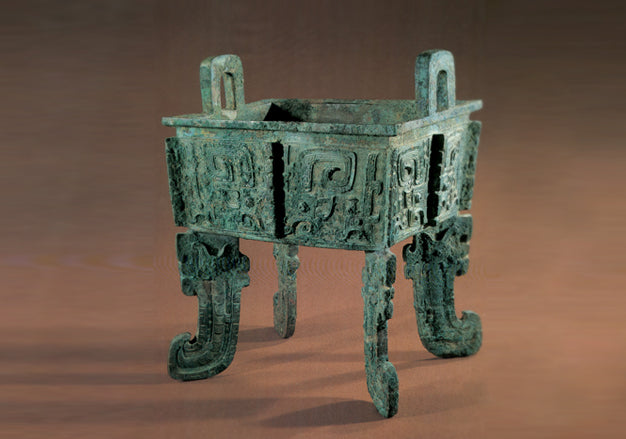
Square Ding with Kui Pattern and Flat Foot

The square tripod with Kui pattern and flat foot is a bronze ritual vessel from the late Shang Dynasty. It is 42.3 cm tall, 34.1 cm long, 24.8 cm wide, 0.5 cm thick, 6.9 cm high, 20.2 cm high, and weighs 18 kg. It was unearthed from the tomb of Fu Hao in Yinxu, Xiaotun Village, Anyang City, Henan Province in 1976.
In the winter of 1975, the Anyang Archaeological Station conducted an investigation on a hill about 100 meters north of Xiaotun Village and discovered several Yin Dynasty house foundations. In 1976, excavations were carried out here, covering an area of about 1,000 square meters. A total of more than 10 Yin Dynasty house foundations, 80 ash pits, and more than 10 Yin Dynasty tombs were discovered. Among them, the tomb of Fu Hao was the main harvest of this excavation [1]. Among them, two square tripods with Kui pattern and flat foot were unearthed, one is kept in the Henan Museum, and the other is kept in the National Museum of China.
Both of these square tripods with Kui patterns and flat feet have rectangular mouths, folded edges, square lips, and two ears standing upright on the mouth edges in the middle of the two short sides. The lower waist is slightly inward, the bottom is nearly flat and slightly smaller than the mouth, and there are four flat and long solid feet, which are shaped like Kui dragons. According to the "Report on the Excavation of Fu Hao's Tomb in Yinxu", when this square tripod with Kui patterns and flat feet collected by Henan Museum was unearthed, the bottom was more damaged, the whole body was heavily rusted, some patterns were not very clear, and silk fabric fragments were attached to one side of the abdomen and one flat foot. In addition, about one-third of the inner bottom of the tripod is missing, and only the character "女" remains in the middle of the inscription "好". However, based on the two characters "妇好" inscribed in the middle of the inner bottom of another flat-footed square tripod, it can be inferred that the inscription of this artifact is "妇好".
From the outside, the square tripod with Kui pattern and flat feet is composed of three parts: ears, belly and flat feet, all of which adopt the "three-layer flower" decoration method: cloud and thunder pattern is used as the ground pattern to set off the theme; thick lines outline the theme framework pattern; and negative lines depict the details of the theme pattern. The outer walls of the two ears are decorated with negative lines of Kui dragon patterns, with the Kui head facing upward. There is a door ridge cast on each of the four corners and the middle of the four sides of the outer wall of the belly of the tripod, and all four sides are decorated with animal face patterns, with a head but no body, and the door ridge as the nose bridge, which is a typical sheep horn animal face pattern (Figure 1). The exaggerated large curled horns on the animal face are similar to the common sheep horns in reality (Figure 2), which is a typical sheep horn animal face pattern. The animal face is in the shape of the character "臣" (Figure 3), with the door ridge as the nose bridge, and there is an inverted Kui dragon pattern on each side of the animal face (Figure 4). Both sides of the feet are decorated with Kuilong patterns, with the head of the Kuilong pointing upward, the mouth exaggeratedly opened, the lips turned outward, the body straight, the body and tail long, curled up, shaped like an inverted L, the body decorated with scales, no feet, and the ground pattern is cloud and thunder pattern. It can be seen that the maker has a superb level of craftsmanship, using relief and round carving decorative techniques to depict the shape of Kuilong so vividly. (Figure 5)

Figure 1 Animal face pattern on the square tripod with Kui pattern and flat foot

Figure 2 Exaggerated large curled horns on the animal face

Figure 3 The animal face with the character "臣" on the square tripod with Kui pattern and flat foot

Figure 4 Inverted Kui dragon pattern on the square tripod with Kui pattern and flat foot

Figure 5 Flat foot with Kui dragon pattern on the square tripod with Kui pattern and flat foot
The discovery of the square tripod with Kui pattern and flat foot is of great significance:
First, the two characters "Fuhao" inscribed in the middle of the inner bottom of the square tripod with Kui pattern and flat foot provide an important reference for confirming the identity of the tomb owner.
Second, the square tripod with Kui pattern and flat foot has a gorgeous appearance, the animal face pattern and Kui dragon pattern are lifelike, and the patterns on the whole body are scattered and well-arranged. It uses the typical "three-layer flower" decoration technique, providing an important specimen for the study of bronze art.


![8.3"China Shang Dynasty,Bronze wine cup [Fuhao Jue cup][妇好爵杯]](http://bronzc.com/cdn/shop/files/4ee0482982cfa89bb4d1cff3333a55e6_e3ca0b86-22fc-497d-9afd-578c551225a3-2.jpg?v=1733986652&width=533)

![12.8" China Ming Dynasty, Phoenix-patterned bronze vase[Ming Wanli Phoenix-patterned vase][明万历凤纹瓶]](http://bronzc.com/cdn/shop/files/4ee0482982cfa89bb4d1cff3333a55e6_a516991b-2bb9-4b2f-a2b6-4354129d006c.jpg?v=1733986953&width=533)

![14.6" China Eastern Han Dynasty Bronze vessel in the shape of a flying horse,Also known as bronze galloping horse[Horse Stepping on Flying Swallow][马踏飞燕]](http://bronzc.com/cdn/shop/files/4ee0482982cfa89bb4d1cff3333a55e6_aa3fbeb8-e08b-4a44-929a-13411ca8fb17-2.jpg?v=1733987211&width=533)

![5.9"China Tang Dynasty, Bronze of a walking dragon[Tang Walking Dragon][唐走龙]](http://bronzc.com/cdn/shop/files/2_8cb416b9-ebbd-4fe2-a905-b9277f820c16.png?v=1731488701&width=533)
